Abstract
BACKGROUND:
Few studies have reported valid comprehensive data on lifestyle habits of Saudi college females. In addition, studies on sedentary behaviors (SBs) and the duration of sleep of Saudi college students are rare. Saudi females appear to be less physically active and therefore, at a higher risk of noncommunicable diseases (NCDs). Therefore, the purpose of this study was to investigate lifestyle patterns of Saudi college females, including physical activity (PA), SBs, duration of sleep, and dietary habits.
MATERIALS AND METHODS:
A cross-sectional study was conducted among females attending health science colleges of King Saud University, using multistage stratified cluster sample (n = 456). Weight, height, PA, SB, sleep, and dietary habits were all assessed using a previously validated questionnaire.
RESULTS:
Nearly half of the college females were physically inactive. Females exercised mostly at home or alone at no specific time of day. Their activity was for health reasons (43.4%) for weight loss (28.7%); lack of time (71.2%) was the primary reason for inactivity. The majority (>85%) of females spent more time in sedentary activity (>3 h/day) while 95% of females had insufficient sleep (<8 h/night). Over 40% of the participants consumed breakfast or vegetables 5 days or more per week, whereas the corresponding proportions for fruit and milk/dairy products intake were 19.4% and 58.4%, respectively. The proportions of college females who consumed less healthy foods for 3+ days/week were fairly variable, ranging from 21.1% for French fries to 60.4% for chocolates/candy. The predictors of total PA time were increased the duration of sleep and reduced intake of French fries/potato chips.
CONCLUSIONS:
Unhealthy lifestyle habit appears prevalent among Saudi college females. Efforts toward promoting PA, decreasing SB, and insufficient sleep and improving dietary habits in Saudi females are needed to reduce future risks of NCDs.
Keywords: College female, dietary habits, physical activity, risk factors, Saudi Arabia, sedentary behaviors, sleep duration
Introduction
According to the World Health Organization (WHO), physical inactivity and low intake of fruits and vegetables are considered some of the major preventable risk factors for noncommunicable diseases (NCDs).[1] Moreover, the WHO identified physical inactivity as the fourth leading risk factor responsible for 6% of deaths globally.[1] To limit the incidence of NCDs and to improve cardiorespiratory and muscle fitness, reduce depression and strengthen bones, current international physical activity (PA) guidelines recommend that an adult must engage in at least 150 min of moderate-intensity aerobic activity or 75 min of vigorous-intensity weekly PA.[2] Furthermore, a recent systematic review revealed that high levels of moderate-intensity PA for 60 min or more per day could eliminate the increased risk of death linked to high sedentary time. Increased PA level may reduce but will not obliterate the high risk related to increased sedentary time of television (TV) viewing.[3]
The transition from secondary school to college is recognized as a critical period involving significant changes in lifestyle behaviors that may influence long-term health.[4,5,6] In addition, the stress level among Saudi university students, particularly in females (75%) more than in males is pretty high (57%).[7] A recent study that examined the changes in lifestyle behaviors in college students during the transition from the final year of high school until the 2nd year of university revealed that students gained an average weight of 2.7 kg, reduced their time spent watching TV and playing computer games while they increased the time spent on the internet and study, reduced sports participation, and the intake of fruit and vegetables during this period.[5] Furthermore, data from the University Life Study, which investigated lifestyle habits of college students for seven semesters, indicated that daily PA, and the consumption of fruit and vegetables declined significantly over the observed period.[8] Further, a large percentage of college students from the United States did not meet the dietary and PA guidelines.[9]
Saudi Arabia has undergone a lifestyle transformation in the past few decades, which has resulted in an increased prevalence of many NCD's risks.[10,11] The recently reported national prevalence of insufficient PA in Saudi youth of 15–24 years old was 41.8% in men and 75.6% in women.[12] In another study that included adolescents aged 14–19 years from three major cities in the country, physical inactivity was estimated as 45.5% and 78.1% for Saudi males and females, respectively.[13] Furthermore, it has been reported that prevalence rates of sedentary behaviors (SBs) and unhealthy dietary habits of Saudi adolescents living in major urban cities are high.[13,14] The studies mentioned above consistently showed that Saudi females were less active and more sedentary than males.[12,13]
Furthermore, the findings of a number of studies that examined lifestyle habits of college students in Saudi Arabia[15,16,17] indicated that over 60% of the college students were physical inactive and had less than healthy dietary habits. Although these observed estimates of physical inactivity of Saudi college-age students appears high, we must remember that most of these studies did not use validated comprehensive PA questionnaire. Studies on SBs and the duration of sleep of Saudi college students are scarce. However, a study of the reasons for being active or inactive and associations with other lifestyle habits of female college students would improve our understanding of the determinants of PA/inactivity in Saudi young females. Therefore, the objective of the present study was to examine the patterns of PA, SBs, sleep duration, and dietary habits of a representative sample of female students attending health science colleges at a major public university in central Saudi Arabia.
Materials and Methods
This was a cross-sectional study involving healthy students without any physical impairment, who were randomly drawn from five health science colleges in King Saud University, Riyadh, Saudi Arabia. Participants were randomly chosen using a multistage stratified cluster sampling technique. The predetermined sample size was calculated so that the sample proportion was within 0.05 of the population proportion with a 95% confidence level. Population proportion was assumed to be at 0.50, as this proportion yields the maximal possible sample size required.[18] We also added 15% for the effect of clustering, so the required sample size came to 442 participants. Eventually, the total number of university students included in this study was 456 females (College of Applied Medical Sciences = 33%; College of Medicine = 31%; College of Pharmacy = 16%; College of Nursing = 11%; and College of Dentistry = 9%). Ethical approval was obtained from the Institutional Review Board Committee of the College of Medicine at King Saud University. Informed written consent was obtained from all participants.
Body weight and height were measured with minimal clothing, without shoes in the morning using standard procedures. Weight was measured to the nearest 100 g using calibrated medical scales, while height was measured to the nearest centimeter using a calibrated measuring rod. Body mass index (BMI) was then calculated by dividing the weight in kilograms over the squared height in meters. Overweight plus obesity level was calculated based on BMI >25 kg/m2.
The Arab Teen Lifestyle Study questionnaire was used to collect lifestyle variables.[7,19] The questionnaire was previously shown to be valid and reliable for the assessment of PA and other lifestyle habits in youth of 14–25 years of age.[20,21] The questionnaire collects information on the frequency, duration, and intensity of light-, moderate-, and vigorous-intensity physical activities during a typical week. It covers several domains of activity including transport, household, fitness, and sports and leisure-time activities. It also includes questions on SBs and the duration of sleep. Time (hours/day) spent using various screens, such as the TV, video games, and computer and internet during the week and at weekends was reported.
The typical duration of sleep in hours on weekdays and at weekends were also stated by the participants. The cutoff hours used for total screen viewing time was below or above 3 h, while that for the duration of sleep was below or above 8 h/day, as this was the recommended minimum normal daily amount for young adults.[22] As to the dietary habits, participants reported on how many days per week they had breakfast, vegetables, fruits, milk and dairy products, sugar-sweetened drinks/soft drinks, fast foods, donuts/cakes, sweets and chocolates, and energy drinks. The participant was given a choice of answers, ranging from zero intakes (never) to a maximum intake of 7 days/week.
The data were analyzed using IBM SPSS software, version 22 (Chicago, IL, USA). Descriptive statistics were presented as means and standard deviations (SD) or proportions. Chi-square test for observed versus expected frequency was used. Inter-relationships between the study variables were determined using Pearson's correlation test. Further, linear regression analysis with step-wise method was used to predict total PA time, average screen viewing time, average duration of sleep, and intake of breakfast using BMI and selected lifestyle variables. The following variables were entered in the regression analyses: BMI, the intake of breakfast, vegetables, fruit, milk, sugar-sweetened drink, fast foods, French fries/potato chips, cake/donuts, chocolates, average screen viewing time per day and average duration of sleep per day. The level of statistical significance was set at P < 0.05.
Results
The mean age (±SD) of the sample was 20.3 ± 1.5 years (18–28 years). The mean (±SD) weight, height, and BMI were 59.9 ± 13.5 kg, 159.9 ± 5.8 cm, and 23.4 ± 4.9 kg/m2, respectively. The percentage of overweight plus obese females in the study was 29.5%. Table 1 shows the differences in selected physical activities (means and standard errors in minutes per week) between active and inactive Saudi females. The prevalence of physically active college females was 54.2%. Further, except for martial arts, where there was no differences between the two groups, active females had obviously spent significantly more time than the inactive females in all types of activities including total and sum of all moderate- and vigorous-intensity PA. The total PA of the participants was nearly 265 min/week. However, the sum of all vigorous-intensity PA only reached 53.3 min/week.
Table 1.
Time (means and standard errors of the mean) spent in different types of physical activity among in-active and active Saudi females
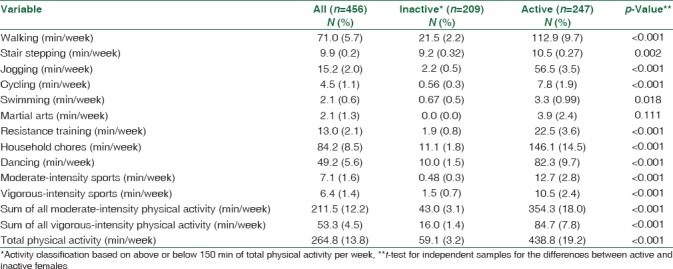
Table 2 exhibits the proportions of Saudi females who exceeded certain cutoff values for screen viewing time, sleep duration, and several healthy and less healthy dietary habits. The majority (>85%) of females spent more time in the sedentary activity of more than 3 h each day. Furthermore, 95% of the females had insufficient sleep (<8 h/night). Over 40% of the study's participants had breakfast or vegetables for 5 days or more per week, while the corresponding proportions for fruit and milk/dairy products intake were 19.4% and 58.4%, respectively. In addition, the proportions of college females who consumed less healthy foods for 3+ days/week were fairly high, ranging from 21.1% for French fries to 60.4% for chocolates/candy. Only 2% of the college females consumed energy drinks for 3 or more days per week.
Table 2.
Screen viewing time and dietary intake frequency per week for female university students
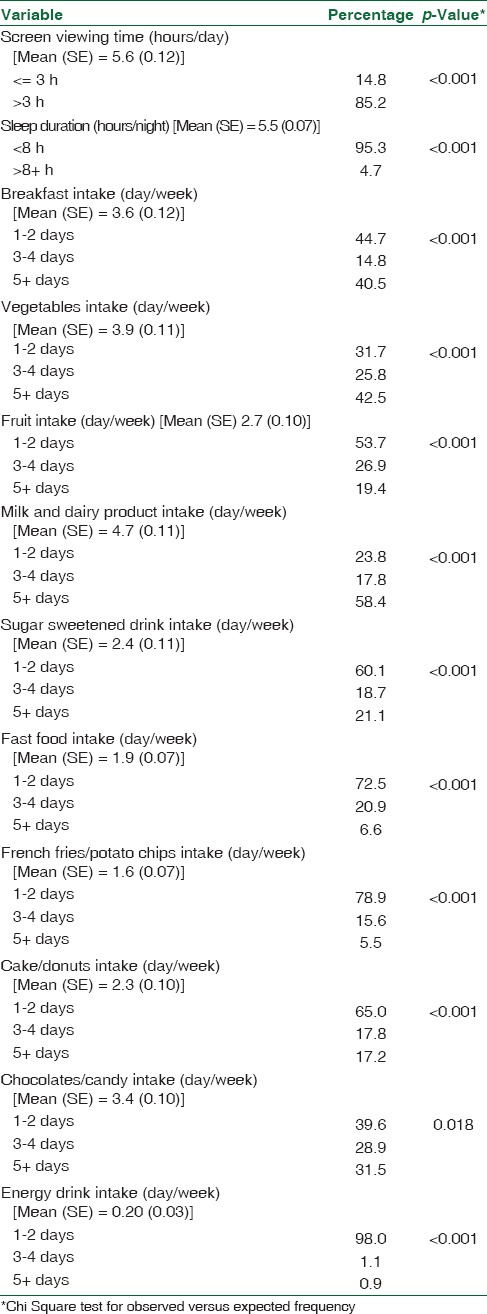
Table 3 shows the participants' responses to questions relating to place and timing of exercise as well as whom they exercised with. The majority of females engaged in PA at home (64.2%) followed by those who exercised on the university premises (20.2%). Most of the participants exercised either alone (70.9%) or with friends (15.9%). In terms of times of the PA, more than 40% of the females had no specific preference. However, some females preferred to exercise in the evening (24.1%) or the morning (17.2%).
Table 3.
Physical activity choices among female university students
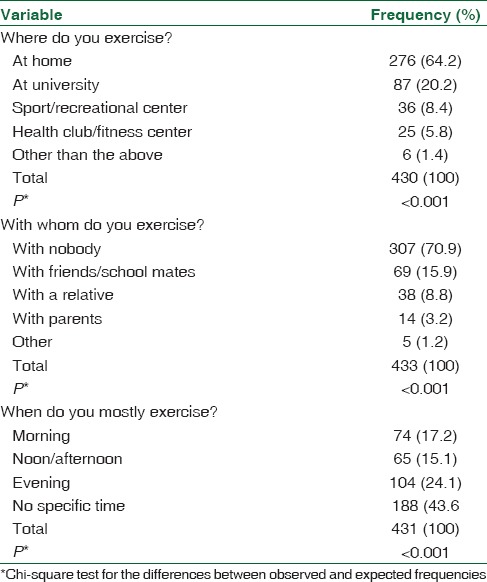
As shown in Figure 1, the most important reasons given by Saudi college females for being active seemed to be healthy (43.4%), followed by weight loss (28.7%) and recreation (18.4%). As to the most important reasons for being inactive [Figure 2], lack of time was the predominant reason (71.2%) by the females. Lack of suitable place and lack of partner accounted for 8.4% and 6.5%, respectively. There were statistically significant (P < 0.001) differences between the responses of the college students to the question on the reasons for being active or inactive.
Figure 1.
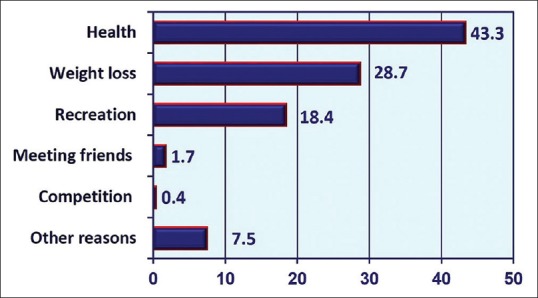
Reasons (%) for being physically active by Saudi college females
Figure 2.
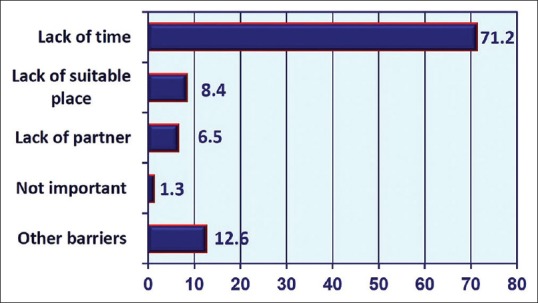
Barriers (%) to physical activity in Saudi college females
PA had significant correlations with duration of sleep (r = 0.583; P < 0.001) and fruit intake (r = 0.146; P = 0.002), but not with screen time or the other dietary intake. On the other hand, SBs were significantly correlated with the intake of fast food (r = 0.210; P < 0.001), French fries/potato chips (r = 0.211; P < 0.001), sugar sweetened drinks (r = 0.215; P < 0.001), Cake and donuts (r = 0.228; P < 0.001), and chocolates/candy (r = 0.231; P < 0.001). Furthermore, PA did not show any significant correlation with screen viewing time (r = −0.013; P = 0.776).
Table 4 displays the proportions of Saudi females above or below cutoff points for PA, screen viewing time, and sleep duration relative to breakfast. There were no significant differences in the proportions of Saudi females who were active versus the inactive (P = 0.514), those who had low versus high screen time (P = 0.932) or those who had insufficient versus sufficient sleep (P = 0.343). Further, the proportions of females at above or below cutoff points for screen time and duration of sleep relative to activity levels are presented in Table 5. There was no significant difference between females who had low versus high screen time (P = 0.168); however, 100% of physically active females had sufficient sleep duration (8 + h) whereas 0% of inactive females sufficient sleep (P < 0.001).
Table 4.
Physical activity, screen viewing time, and sleep duration relative to breakfast category
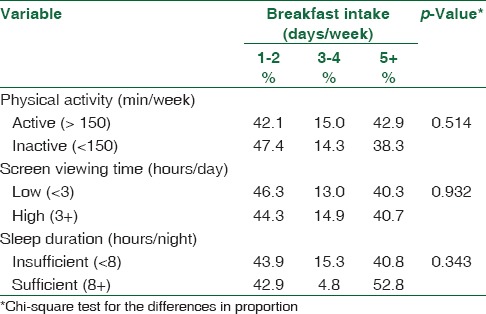
Table 5.
Screen viewing time and sleep duration relative to activity category
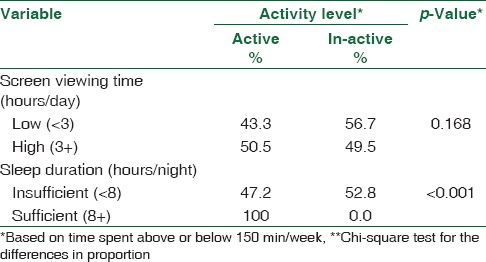
The results of multiple linear regression analyses for the prediction of the total duration of PA, average viewing screen time, breakfast intake, and average duration of sleep are shown in Table 6. The significant independent predictors of total duration spent in PA are average sleep duration and intake of French fries/potato chips (r = 0.484 and R2= 0.234). This means that these two predictors can explain 23% of the variance in participants' total PA. The independent predictors of the intake of breakfast, vegetables, milk/dairy product, and fast food with multiple R2= 0.155. The average screen viewing time can be significantly predicted using the intake of cake/donuts, sugar-sweetened drink, and the consumption of fast food (R2= 0.076), while the main predictor of average duration of sleep is the intake of vegetables (R2= 0.017).
Table 6.
Results of multiple regression analyses for the prediction of selected lifestyle variables among Saudi university females

Discussion
This study has described the patterns of PA, SBs, sleep duration, and dietary habits of a representative sample of Saudi female students attending five health science colleges at King Saud University. The main finding of the study was that unhealthy lifestyle habits appear to be prevalent among Saudi college females. Most of these females were physically inactive, had high SBs, and their consumption of breakfast, fruit, and vegetables was infrequent. These findings were consistent with previous research results on college students from different countries.[9,10,11,13,14,23] A healthy diet and an active lifestyle play an important role in the prevention of chronic NCDs, such as diabetes, cardiovascular diseases, and cancer.[1]
The benefits of health-enhancing PA for humans are well established.[2,24] Insufficient PA, on the other hand, is considered a major risk factor for NCDs and total mortality.[25] The findings of the present study indicate that nearly 46% of the college females did not attain the recommended daily PA level. This confirms earlier results on high prevalence of physical inactivity of Saudi adolescents,[26] and youth.[6] The proportion of inactive college females reported in our study appeared lower than what had been previously reported for Saudi university females. For example, a cross-sectional study involving female medical students at King Khalid University in Abha, southwestern Saudi Arabia, showed that nearly 61% of the females were physically inactive.[17] Furthermore, a recent study from Majmaah University found that over 62% of the students from health science colleges were inactive.[14] The disparity in the prevalence of inactivity could be due to either the regional variations or to the use of different PA instruments. However, the PA questionnaire used in our study had been previously validated.[20] Elsewhere, 48.4% of Spanish university females were reported to be physically active.[27] Further, earlier meta-analysis reviews involving university population reported that about 40%–50% of college students were considered physically inactive.[28]
A large percentage of females in the present study engaged in PA at home and some exercised on the university premises. In comparison with the findings of the present study, a study conducted on Saudi undergraduate medical students in western Saudi Arabia reported that more females (36%) than males (13%) exercised at home.[29] No doubt cultural factors play a strong role in the participation of Saudi females in PA, as there are fewer opportunities for public exercise for females compared with males. Therefore, most Saudi females are likely to engage in PA at home, as the findings of the current study have indicated. However, home-based PA was previously reported to account for the smallest percentage (11%) of total PA done by adolescents.[30] Further, a study of the cultural influence on personal and behavioral correlates of low PA of college students in the United States, Costa Rica, India, and South Korea recommended that culturally sensitive interventions were to be used to promote PA in young adults.[31]
Saudi college females reported in the current study that the most important reasons for being active were for health followed by weight loss. These findings agree with responses by undergraduate medical students of King Abdulaziz University in western Saudi Arabia, which indicated that the main reason for PA was to promote and maintain health, then control weight and prevent obesity.[29] In addition, previous reviews of PA behaviors showed that the most important factor for college students to engage in PA or to attend PA courses was to have fun.[28]
The most commonly reported reason by female college students for physical inactivity in the present research was the lack of time. Insufficient time always appears as a major barrier to PA and was more likely to decrease the likelihood of engagement in regular PA.[32] In a local study conducted on Saudi students from Majmaah University, the most common reason for being inactive was time.[15] For females, undergraduate medical students from King Abdulaziz University the lack of time was perceived as the main barrier to engaging in PA.[29]
The majority (>85%) of college females in the present study spent more time in sedentary activity lasting 3 h or more daily. SBs appeared to be linked to adverse health outcomes in a way that is somewhat different from those ascribed to the lack of PA.[33] Moreover, in the adolescent population, PA was shown to be related more with healthy dietary choices, while SBs appeared to be associated more with unhealthy dietary habits.[7] Indeed, in the present study, screen viewing time was significantly related to several less healthy dietary habits, whereas PA showed significant correlation with fruit intake.
Our findings indicated that over 40% of the study participants consumed breakfast or vegetables for 5 days or more per week, while those who had fruit or milk/dairy products for 5 days or more per week were 19.4% and 58.4%, respectively. These findings agree with those of many published studies involving college females. The majority of college students have unhealthy lifestyle habits, including skipping breakfast, low fruits and vegetables consumption, high fast food intake, and low levels of PA.[23,29,34,35] Further, recent findings showed that nearly 30% of students from health science colleges at Majmaah University skipped breakfast at home, whereas almost one-quarter of them consumed soft drinks more than four times per day.[15] In addition, more than 50% of Bahraini University students skipped breakfast and females were more likely than males to spend time watching TV and surfing the internet and be less physically active.[36]
Getting good quality sleep is vital to the individual's physical and mental health.[22] Our study showed that a great proportion of the females had insufficient sleep and that PA but not SBs significantly correlated with sleep duration (r = 0.583). Poor quality of sleep was found to be widespread (54%) among undergraduate female students at King Faisal University in eastern Saudi Arabia, with a mean total sleep duration of 5 h/day, and that poor sleep was associated with low PA (odds ratio [OR] 2.05, P = 0.037), and skipping breakfast (OR 2.71, P = 0.003).[37] In comparison with our findings, a study involving Saudi adolescents showed that 50% of the participants had <8 h of daily sleep and that little sleep was significantly associated with several lifestyle factors, especially low PA and low intake of breakfast.[38]
Identifying the predictors of PA can help to develop effective PA interventions and strategies.[39] In the present study, the significant independent predictors of females' total PA time were sufficient sleep and low intake of French fries/potato chips. In addition, the predictor of low PA of college students from the United States, Costa Rica, India, and South Korea was reported as low intake of fruit and vegetables.[31] Several personal, psychological, and environmental factors can impact on the PA of college students. Using a qualitative research, Deliens et al. reported that university students' PA and SBs were influenced by elements related to individual factors, social networks, and physical environment.[40] The study also observed that the relationships between determinants of university students' PA and SBs appeared to be moderated by university characteristics, such as residence, university lifestyle, examinations, and academic pressure.[40] Therefore, to promote PA among university students, a multiple-level approach of personal, psychosocial, and environmental factors is needed to examine PA behaviors of the student population.[28] Besides, extracurricular sports activities for females are somewhat inadequate at King Saud University as they are in most universities in Saudi Arabia.
Finally, the present study has its strengths and limitations. We used a validated comprehensive PA questionnaire that covered all domains of PA. The sample size in this study was adequate and representative of students attending health science colleges in a large public university. However, an area of the limitations of the current study is the potential recall bias in participants' reporting of PA data. Furthermore, the cross-sectional nature of this research does not imply causal relationships between the selected variables. Further, the study is limited to the students from the health science colleges and did not include students from the arts, natural sciences or the humanities. Furthermore, the results of multiple linear regression analyses for the prediction of PA duration, viewing screen time, and the intake of breakfast can be confounded by the lack of sociodemographic factors, which were not collected in the present study.
Conclusions
The findings of the present study indicate that unhealthy lifestyle habits, including physical inactivity, SBs, insufficient sleep, and unhealthy eating habits, were prevalent among Saudi college females. Efforts toward promoting PA, reducing SBs, and improving sleep and dietary habits of Saudi females are needed to reduce the future NCD's risks. Implementing behavioral intervention programs on the university campus may be the first step to removing barriers to healthy living habits and may substantially enhance the health and well-being of female college students.
Financial support and sponsorship
This study was funded by the Deanship of Scientific Research at King Saud University, Riyadh, Saudi Arabia.
Conflicts of interest
There are no conflicts of interest.
Acknowledgments
We would like to thank all the participants for taking part in this study.
References
- 1.World Health Organization. Global Health Risks: Mortality and Burden of Disease Attributable to Selected Major Risks. Geneva, Switzerland: WHO; 2009. [Google Scholar]
- 2.World Health Organization. Global Recommendations on Physical Activity for Health. Geneva, Switzerland: WHO; 2010. [PubMed] [Google Scholar]
- 3.Ekelund U, Steene-Johannessen J, Brown WJ, Fagerland MW, Owen N, Powell KE, et al. Does physical activity attenuate, or even eliminate, the detrimental association of sitting time with mortality? A harmonised meta-analysis of data from more than 1 million men and women. Lancet. 2016;388:1302–10. doi: 10.1016/S0140-6736(16)30370-1. [DOI] [PubMed] [Google Scholar]
- 4.Crombie AP, Ilich JZ, Dutton GR, Panton LB, Abood DA. The freshman weight gain phenomenon revisited. Nutr Rev. 2009;67:83–94. doi: 10.1111/j.1753-4887.2008.00143.x. [DOI] [PubMed] [Google Scholar]
- 5.Deforche B, Van Dyck D, Deliens T, De Bourdeaudhuij I. Changes in weight, physical activity, sedentary behaviour and dietary intake during the transition to higher education: A prospective study. Int J Behav Nutr Phys Act. 2015;12:16. doi: 10.1186/s12966-015-0173-9. [DOI] [PMC free article] [PubMed] [Google Scholar]
- 6.Racette SB, Deusinger SS, Strube MJ, Highstein GR, Deusinger RH. Changes in weight and health behaviors from freshman through senior year of college. J Nutr Educ Behav. 2008;40:39–42. doi: 10.1016/j.jneb.2007.01.001. [DOI] [PubMed] [Google Scholar]
- 7.Abdulghani HM, AlKanhal AA, Mahmoud ES, Ponnamperuma GG, Alfaris EA. Stress and its effects on medical students: A cross-sectional study at a college of medicine in Saudi Arabia. J Health Popul Nutr. 2011;29:516–22. doi: 10.3329/jhpn.v29i5.8906. [DOI] [PMC free article] [PubMed] [Google Scholar]
- 8.Small M, Bailey-Davis L, Morgan N, Maggs J. Changes in eating and physical activity behaviors across seven semesters of college: Living on or off campus matters. Health Educ Behav. 2013;40:435–41. doi: 10.1177/1090198112467801. [DOI] [PMC free article] [PubMed] [Google Scholar]
- 9.Huang TT, Harris KJ, Lee RE, Nazir N, Born W, Kaur H. Assessing overweight, obesity, diet, and physical activity in college students. J Am Coll Health. 2003;52:83–6. doi: 10.1080/07448480309595728. [DOI] [PubMed] [Google Scholar]
- 10.Musaiger AO, Al-Hazzaa HM. Prevalence and risk factors associated with nutrition-related noncommunicable diseases in the eastern mediterranean region. Int J Gen Med. 2012;5:199–217. doi: 10.2147/IJGM.S29663. [DOI] [PMC free article] [PubMed] [Google Scholar]
- 11.Rahim HF, Sibai A, Khader Y, Hwalla N, Fadhil I, Alsiyabi H, et al. Non-communicable diseases in the Arab world. Lancet. 2014;383:356–67. doi: 10.1016/S0140-6736(13)62383-1. [DOI] [PubMed] [Google Scholar]
- 12.Moradi-Lakeh M, El Bcheraoui C, Tuffaha M, Daoud F, Al Saeedi M, Basulaiman M, et al. The health of Saudi youths: Current challenges and future opportunities. BMC Fam Pract. 2016;17:26. doi: 10.1186/s12875-016-0425-z. [DOI] [PMC free article] [PubMed] [Google Scholar]
- 13.Al-Hazzaa HM, Abahussain NA, Al-Sobayel HI, Qahwaji DM, Musaiger AO. Physical activity, sedentary behaviors and dietary habits among Saudi adolescents relative to age, gender and region. Int J Behav Nutr Phys Act. 2011;8:140. doi: 10.1186/1479-5868-8-140. [DOI] [PMC free article] [PubMed] [Google Scholar]
- 14.Al-Hazzaa HM, Al-Sobayel HI, Abahussain NA, Qahwaji DM, Alahmadi MA, Musaiger AO, et al. Association of dietary habits with levels of physical activity and screen time among adolescents living in Saudi Arabia. J Hum Nutr Diet. 2014;27(Suppl 2):204–13. doi: 10.1111/jhn.12147. [DOI] [PubMed] [Google Scholar]
- 15.Alfhaid F, Alzahrani M, Almansour M, Alghamdi T, Ansari T, Waqas S, et al. Lifestyle of health sciences students at Majmaah University, Saudi Arabia. Australas Med J. 2017;10:111–6. [Google Scholar]
- 16.Khalaf A, Ekblom Ö, Kowalski J, Berggren V, Westergren A, Al-Hazzaa H, et al. Female university students' physical activity levels and associated factors – A cross-sectional study in Southwestern Saudi Arabia. Int J Environ Res Public Health. 2013;10:3502–17. doi: 10.3390/ijerph10083502. [DOI] [PMC free article] [PubMed] [Google Scholar]
- 17.Saleem SA, Alahmari RS, Alahmari MS. Dietary habits among female medical student in King Khalid University, Abha City, 2014. Int J Med Sci Public Health. 2016;5:1268–74. [Google Scholar]
- 18.Krejcie RV, Morgan DW. Determining sample size for research activities. Educ Psychol Meas. 1970;30:607–10. [Google Scholar]
- 19.Al-Hazzaa HM, Musaiger AO ATLS Research Group. Arab Teens Lifestyle Study (ATLS): Objectives, design, methodology and implications. Diabetes Metab Syndr Obes. 2011;4:417–26. doi: 10.2147/DMSO.S26676. [DOI] [PMC free article] [PubMed] [Google Scholar]
- 20.Al-Hazzaa HM, Al-Sobayel HI, Musaiger AO. Convergent validity of the Arab teens lifestyle study (ATLS) physical activity questionnaire. Int J Environ Res Public Health. 2011;8:3810–20. doi: 10.3390/ijerph8093810. [DOI] [PMC free article] [PubMed] [Google Scholar]
- 21.Al-Hazzaa HM, Al-Ahmadi M. A self-reported questionnaire for the assessment of physical activity in youth 15-25 years: Development, reliability and construct validity. Arab J Food Nutr. 2003;4:279–91. [Google Scholar]
- 22.Hirshkowitz M, Whiton K, Albert SM, Alessi C, Bruni O, DonCarlos L, et al. National sleep foundation's sleep time duration recommendations: Methodology and results summary. Sleep Health. 2015;1:40–3. doi: 10.1016/j.sleh.2014.12.010. [DOI] [PubMed] [Google Scholar]
- 23.El-Kassas G, Ziade F. Exploration of the dietary and lifestyle behaviors and weight status and their self-perceptions among health sciences university students in North Lebanon. Biomed Res Int. 2016;2016:9762396. doi: 10.1155/2016/9762396. [DOI] [PMC free article] [PubMed] [Google Scholar]
- 24.Physical Activity Guidelines for Americans: Be Active, Healthy and Happy. Washington, USA: United States Department of Health and Human Services; 2008. United States Department of Health and Human Services. [Google Scholar]
- 25.Lee IM, Shiroma EJ, Lobelo F, Puska P, Blair SN, Katzmarzyk PT. Effect of physical inactivity on major non-communicable diseases worldwide: An analysis of burden of disease and life expectancy. Lancet. 2012;380:219–29. doi: 10.1016/S0140-6736(12)61031-9. [DOI] [PMC free article] [PubMed] [Google Scholar]
- 26.Al-Hazzaa HM, Alahmadi MA, Al-Sobayel HI, Abahussain NA, Qahwaji DM, Musaiger AO. Patterns and determinants of physical activity among Saudi adolescents. J Phys Act Health. 2014;11:1202–11. doi: 10.1123/jpah.2012-0427. [DOI] [PubMed] [Google Scholar]
- 27.Romaguera D, Tauler P, Bennasar M, Pericas J, Moreno C, Martinez S, et al. Determinants and patterns of physical activity practice among Spanish university students. J Sports Sci. 2011;29:989–97. doi: 10.1080/02640414.2011.578149. [DOI] [PubMed] [Google Scholar]
- 28.Keating XD, Guan J, Piñero JC, Bridges DM. A meta-analysis of college students' physical activity behaviors. J Am Coll Health. 2005;54:116–25. doi: 10.3200/JACH.54.2.116-126. [DOI] [PubMed] [Google Scholar]
- 29.Alissa EM, Alsawadi H, Zedan A, Alqarni D, Bakry M, Bin Hli N. Knowledge, attitude and practice of dietary and lifestyle habits among medical students in King Abdulaziz University, Saudi Arabia. Int J Nutr Food Sci. 2015;4:650–5. [Google Scholar]
- 30.De Cocker K, Ottevaere C, Sjöström M, Moreno LA, Wärnberg J, Valtueña J, et al. Self-reported physical activity in European adolescents: Results from the HELENA (Healthy lifestyle in Europe by nutrition in adolescence) study. Public Health Nutr. 2011;14:246–54. doi: 10.1017/S1368980010000558. [DOI] [PubMed] [Google Scholar]
- 31.Seo DC, Torabi MR, Jiang N, Fernandez-Rojas X, Park BH. Cross-cultural comparison of lack of regular physical activity among college students: Universal versus transversal. Int J Behav Med. 2009;16:355–9. doi: 10.1007/s12529-008-9029-x. [DOI] [PubMed] [Google Scholar]
- 32.Tergerson JL, King KA. Do perceived cues, benefits, and barriers to physical activity differ between male and female adolescents? J Sch Health. 2002;72:374–80. doi: 10.1111/j.1746-1561.2002.tb03562.x. [DOI] [PubMed] [Google Scholar]
- 33.Tremblay MS, Colley RC, Saunders TJ, Healy GN, Owen N. Physiological and health implications of a sedentary lifestyle. Appl Physiol Nutr Metab. 2010;35:725–40. doi: 10.1139/H10-079. [DOI] [PubMed] [Google Scholar]
- 34.Papadaki A, Hondros G, Scott AJ, Kapsokefalou M. Eating habits of university students living at, or away from home in Greece. Appetite. 2007;49:169–76. doi: 10.1016/j.appet.2007.01.008. [DOI] [PubMed] [Google Scholar]
- 35.Sajwani RA, Shoukat S, Raza R, Shiekh MM, Rashid Q, Siddique MS, et al. Knowledge and practice of healthy lifestyle and dietary habits in medical and non-medical students of Karachi, Pakistan. J Pak Med Assoc. 2009;59:650–5. [PubMed] [Google Scholar]
- 36.Musaiger AO, Awadhalla MS, Al-Mannai M, AlSawad M, Asokan GV. Dietary habits and sedentary behaviors among health science university students in Bahrain. Int J Adolesc Med Health. 2017;29:pii:/j/ijamh. doi: 10.1515/ijamh-2015-0038. 2017.29.issue-2/ijamh-2015-0038/ijamh-2015-0038.xml. [DOI] [PubMed] [Google Scholar]
- 37.Al-Otaibi HH. Associations between sleep quality and different measures of obesity in Saudi Adults. Glob J Health Sci. 2016;9:57770. [Google Scholar]
- 38.Al-Hazzaa HM, Musaiger AO, Abahussain NA, Al-Sobayel HI, Qahwaji DM. Lifestyle correlates of self-reported sleep duration among Saudi adolescents: A multicentre school-based cross-sectional study. Child Care Health Dev. 2014;40:533–42. doi: 10.1111/cch.12051. [DOI] [PubMed] [Google Scholar]
- 39.Sallis JF, Prochaska JJ, Taylor WC. A review of correlates of physical activity of children and adolescents. Med Sci Sports Exerc. 2000;32:963–75. doi: 10.1097/00005768-200005000-00014. [DOI] [PubMed] [Google Scholar]
- 40.Deliens T, Deforche B, De Bourdeaudhuij I, Clarys P. Determinants of physical activity and sedentary behaviour in university students: A qualitative study using focus group discussions. BMC Public Health. 2015;15:201. doi: 10.1186/s12889-015-1553-4. [DOI] [PMC free article] [PubMed] [Google Scholar]


